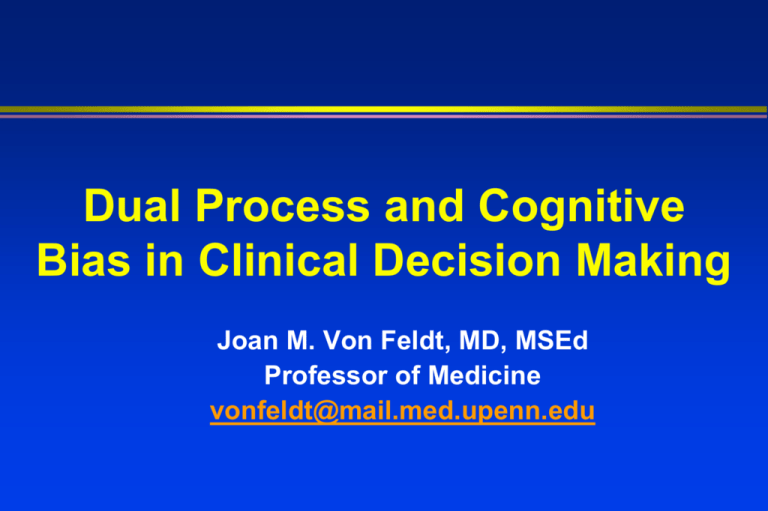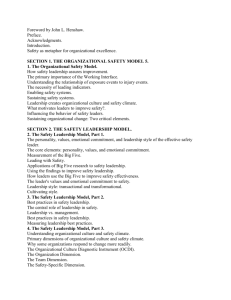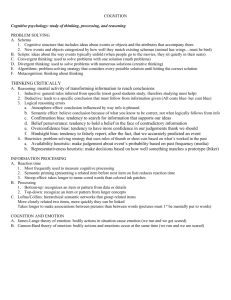Dual Process and Cognitive Bias in Clinical Decision Making
advertisement

Dual Process and Cognitive Bias in Clinical Decision Making Joan M. Von Feldt, MD, MSEd Professor of Medicine vonfeldt@mail.med.upenn.edu Thinking Fast and Slow Daniel Kahneman Approaches to Decision Making Modular responsivity Deliberation without attention Thin Slicing Inductive reasoning Recognition Primed Heuristics and Biases Intuitive Hypothetico-deductive reasoning Gestalt effect Robust Decision Making Exhaustion Strategy Bounded rationality Normative reasoning Bayesian reasoning Analytical Croskerry. Adv in Health Sci Ed 2009; 14:27-35 Properties of the 2 types of decision-making Cognitive Style Cognitive Awareness Automaticity Rate Effort Emotional Component Scientific Rigor Errors System I (Intuitive) Heuristic Low High Fast Low High System II (Analytical) Systematic High Low Slow High Low Low More High Less Examples: System 1 & 2 Thinking Your route to work An out of town guest staying with you who will meet you at your work Your route to work after being away for 20 years or major road work Model for diagnostic reasoning based on pattern recognition and dual-process theory Croskerry P. Clinical cognition and diagnostic error: applications of a dual process model of reasoning. Adv Health Sci Educ Theory Pract. 2009 Sep;14 Suppl 1:27-35. Heuristics Pattern Recognition Illness Scripts Gestalt Instance Scripts i.e “Blink”; “Thinking Fast” Heuristics Can be good: » provide cognitive “short cuts” in the face of complex situations » Help us to be efficient Can be bad: » They tend to be thinking traps – so beware! » Can adversely influence our diagnostic decisions Croskerry, P. Acad Med 2003; 78:775-80. Institute of Medicine Report Published in 1999 Addressed the problem of preventable medical errors Charged the healthcare industry to evaluate and change their systems to prevent patient harm Systems Errors: Complicated Cognitive Errors: Just As Complicated…But In A Different Way Cognitive Error Categories Faulty Knowledge Faulty Data Gathering Faulty Information Processing Faulty Verification Origins of diagnostic error in 100 patients 19% related to Systems Error Didn’t expand your differential diagnosis….. 28% related to Cognitive Error Forgot to f/u on the blood cultures… 46% related to both Systems and Cognitive Errors Poor communication among consultants….. Leape LL, et al. N Engl J Med 1991; 324(6): 377-84. Graber ML. Franklin N. Gordon R. Diagnostic error in internal medicine. Archives of Internal Medicine, 2005; 165(13): 1493-9. Anchoring Bias Also called “premature closure” the failure to continue considering reasonable alternatives after a primary diagnosis is reached, is the most common diagnostic error ie When the diagnosis is made, the thinking stops Croskerry, P. Acad Med 2003; 78:775-80. Confirmation Bias Confirmation bias Tendency to look for confirming evidence to support a diagnosis rather than look for discomfirming evidence to refute it (despite the latter often being more persuasive and definitive) Absolutely! Croskerry, P. Acad Med 2003; 78:775-80. Availability Availability bias Judge things as being more likely if they readily come to mind Croskerry, P. Acad Med 2003; 78:775-80. Unpacking Principle The failure to elicit all relevant information in establishing a differential diagnosis that may result in significant possibilities being missed Croskerry, P. Acad Med 2003; 78:775-80. Framing Effect The framing of the patient scenario, including the source and where the patient is seen, influences the way the patient is thought about Croskerry, P. Acad Med 2003; 78:775-80 Diagnosis Momentum Also known as “chartlore”- once diagnostic labels are attached to patients, they become stickier and stickier Croskerry, P. Acad Med 2003; 78:775-80. Visceral Bias Counter-transference negative feelings towards a patient may result in diagnoses being missed Common Types » » » » Non-compliant patients Homeless patients Patients with chronic pain Obese patients Cognitive Bias Can Lead to Errors in Diagnosis How Do We Deconstruct Our “Brick Walls”? 5 Basic Questions to Help Avoid Cognitive Errors What are traps I might fall into What else can it be? Is there anything that doesn’t fit? Is there’s more than one thing going on? Is this a case where I need to “slow down”? Summary Heuristics are important for efficiency of care Heuristics can also be used for expediency of care that may compromise optimum care Cognitive bias is an important factor that can adversely influence diagnostics Thorough problem lists and broad differentials can mitigate some cognitive bias MD 305 rule: Minimum of 3 diagnoses, 2 organ systems ???






